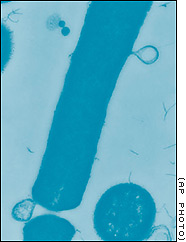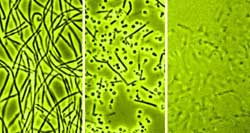August
2002: A New Weapon Against Anthrax?
August
2002: Researchers from Rockerfeller
University in New York have used an ancient enemy of
bacteria to fashion the latest weapon in the fight against
the deadly anthrax bacterium. Knowing that bacteriophage,
viruses that infect bacteria, could infect and kill
anthrax bacteria, they extracted the enzyme (PlyG lysin)
that the virus uses to burst and kill its anthrax host.
The enzyme latches on to the bacterium and causes it
to burst (see below).
Bacteriophage
are described on pages 289-290 and 482-485 of the Dragonfly
book.
How
the treatment works:

The
electron micrograph above shows what happens to bacteria treated
with the enzyme. Their cell wall breaks down, and they lyse (break
open) due to osmotic pressure. The two little bubbles show the bacterium's
cell membrane bursting through its cell wall.
For
more information on this scientific development:
NATURE Science Update carried an on-line version of the story:
http://www.nature.com/nsu/nsu_pf/020819/020819-6.html
Scientific
American
pointed out that this new approach could lead to advances in detection
of anthrax spores as well.
A
Press Release
from Rockerfeller University, where the research was carried out
in the laboratory of Vincent
A. Fischetti, describes some of the details of the work:
This
series of micrographs shows the phage enzyme completely wiping
out a colony of Bacillus cereus, the cousin strain of anthrax
used in the Rockerfeller study. The left panel shows a healthy
colony of bacteria; the middle panel shows the bacteria 1 minute
after enzyme treatment; and the right shows them 15 minutes after
treatment.
|
|
|
|
How the treatment works:
The electron micrograph above shows what happens to bacteria treated with the enzyme. Their cell wall breaks down, and they lyse (break open) due to osmotic pressure. The two little bubbles show the bacterium's cell membrane bursting through its cell wall. |
|
(A web site developed by Ken Miller and Joe Levine to provide scientific and education support for teachers and students using our textbooks)

